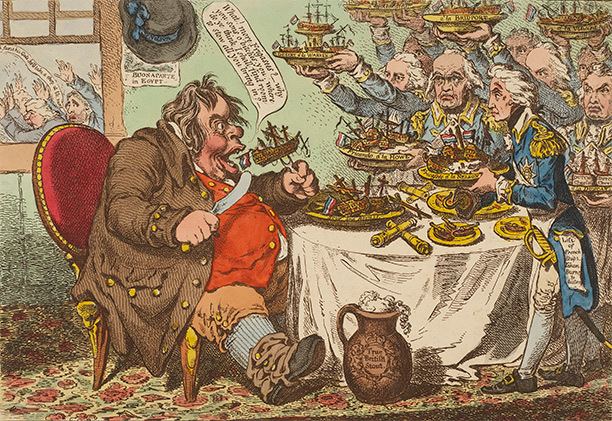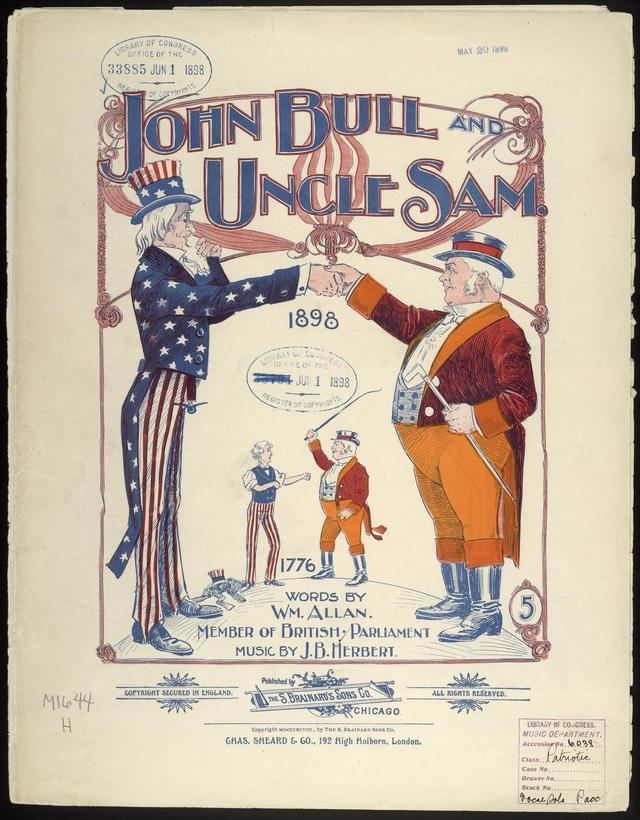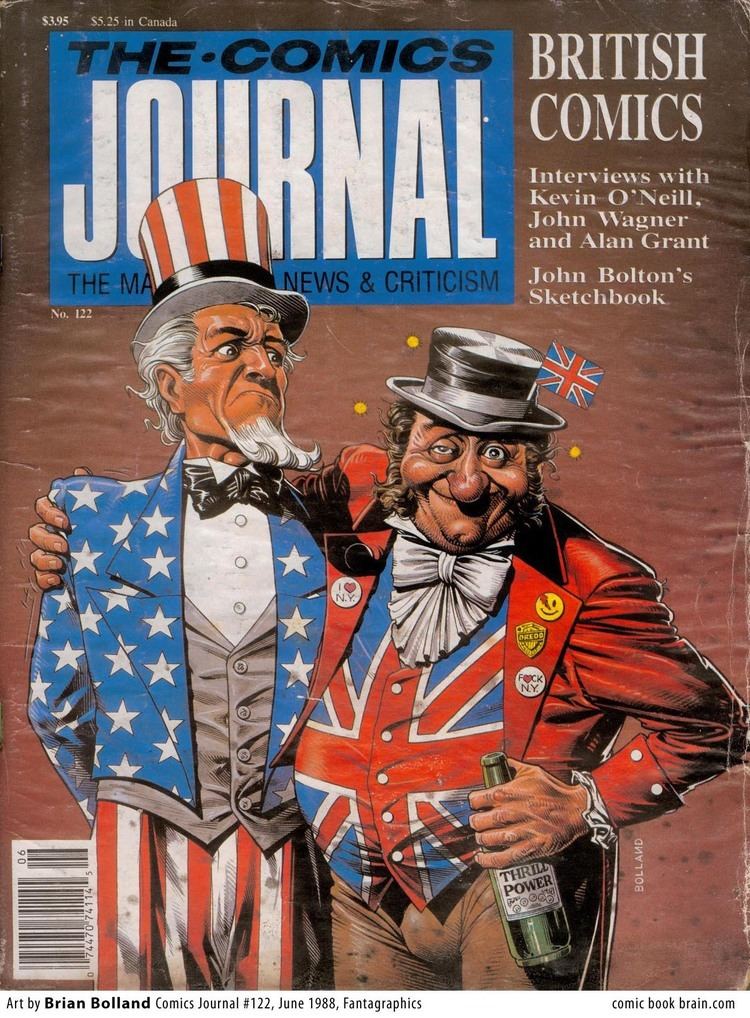 | ||
Similar Uncle Sam, Johnny Reb, Lady of the Mountain, Juan dela Cruz, Zé Povinho | ||
John Bull is a national personification of the United Kingdom in general and England in particular, especially in political cartoons and similar graphic works. He is usually depicted as a stout, middle-aged, country dwelling, jolly, matter-of-fact man.
Contents

Origin

John Bull originated in the creation of Dr. John Arbuthnot, a friend of Jonathan Swift (author of Gulliver's Travels) and satirist Alexander Pope in 1712, and was popularised first by British print makers. Arbuthnot created Bull in his pamphlet Law is a Bottomless Pit (1712). The same year Arbuthnot published a four-part political narrative The History of John Bull. In this satirical treatment of the War of the Spanish Succession a bold, honest and forthright clothier John Bull brings a lawsuit against various figures intended to represent the kings of France and Spain as well as institutions both foreign and domestic.

Originally derided, William Hogarth and other British writers made Bull "a heroic archetype of the freeborn Englishman." Later, the figure of Bull was disseminated overseas by illustrators and writers such as American cartoonist Thomas Nast and Irish writer George Bernard Shaw, author of John Bull's Other Island.

Starting in the 1760s, Bull was portrayed as an Anglo-Saxon country dweller. He was almost always depicted in a buff-coloured waistcoat and a simple frock coat (in the past Navy blue, but more recently with the Union Jack colours). Britannia, or a lion, is sometimes used as an alternative in some editorial cartoons.

As a literary figure, John Bull is well-intentioned, frustrated, full of common sense, and entirely of native country stock. Unlike Uncle Sam later, he is not a figure of authority but rather a yeoman who prefers his small beer and domestic peace, possessed of neither patriarchal power nor heroic defiance. Arbuthnot provided him with a sister named Peg (Scotland), and a traditional adversary in Louis Baboon (the House of Bourbon in France). Peg continued in pictorial art beyond the 18th century, but the other figures associated with the original tableau dropped away. John Bull himself continued to frequently appear as a national symbol in posters and cartoons as late as World War I.
Portrayal
Bull is usually portrayed as a stout, portly man in a tailcoat with light-coloured breeches and a top hat which by its shallow crown indicates its middle class identity. During the Georgian period his waistcoat is red and/or his tailcoat is royal blue which, together with his buff or white breeches, can thus refer to a greater or lesser extent to the "blue and buff" scheme, used by supporters of Whig politics which is part of what John Arbuthnot wished to deride when he invented the character. By the twentieth century however his waistcoat nearly always depicts a Union Flag, and his coat is generally dark blue (but otherwise still echoing the fashions of the Regency period). He also wears a low topper (sometimes called a John Bull topper) on his head and is often accompanied by a bulldog. John Bull has been used in a variety of different ad campaigns over the years, and is a common sight in British editorial cartoons of the 19th and early 20th centuries. Singer David Bowie famously wore a coat worn in the style of Bull.
Washington Irving described him in his chapter entitled "John Bull" from The Sketch Book:
The cartoon image of stolid, stocky, conservative and well-meaning John Bull, dressed like an English country squire, sometimes explicitly contrasted with the conventionalised scrawny, French revolutionary sans-culottes Jacobin, was developed from about 1790 by British satirical artists James Gillray, Thomas Rowlandson and George Cruikshank. (An earlier national personification was Sir Roger de Coverley, from The Spectator.)
In 1966, The Times, criticising the Unionist government of Northern Ireland, famously branded the province "John Bull's Political Slum".
Increasingly through the early twentieth century, John Bull became seen as not particularly representative of "the common man", and during the First World War this function was largely taken over by the figure of Tommy Atkins.
John Bull's surname is also reminiscent of the alleged fondness of the English for beef, reflected in the French nickname for English people, les rosbifs (the "Roast Beefs"). It is also reminiscent of the animal, and for that reason Bull is portrayed as "virile, strong, and stubborn" like a bull.
A typical John Bull Englishman is referenced in Margaret Fuller's Summer on the Lakes, in 1843 in Chapter 2: "Murray's travels I read, and was charmed by their accuracy and clear broad tone. He is the only Englishman that seems to have traversed these regions, as man, simply, not as John Bull."
In fiction
In Jules Verne's novel The Mysterious Island a character calls some unseen adversaries "sons of John Bull!", which is explained with: "When Pencroft, being a Yankee, treated any one to the epithet of 'son of John Bull,' he considered he had reached the last limits of insult."
Some John Bull imagery appears in the first volume of The League of Extraordinary Gentlemen by Alan Moore and Kevin O'Neill. John Bull is visible in the illustration accompanying the foreword, on a matchbox on the comic's first page and in person at the bottom of the final panel.
In the Japanese anime Hellsing Ultimate, Alucard refers to Walter, the Hellsing family butler, as "John Bull" on a few occasions, often in mockery.
In the highly acclaimed Clint Eastwood film Unforgiven, a character by the nickname of "English Bob" (played by Richard Harris) is given a brief back story of having worked for the railroad, shooting "Chinamen" who try to escape the forced labour camps. Riding a train with his biographer, W.W. Beauchamp, it is apparent to others on the train without introduction that English Bob is British (presumably because of his accent). One belligerent continues to use the term "John Bull" derisively, intentionally loud enough to provoke English Bob. The conversation is in reference to the recent assassination of President Garfield by Charles J. Guiteau. The belligerent is more careful with his attitude when warned that this may be the famous gunman English Bob. Bob continues the provocation with a suggestion that America should choose a monarch, since one is not so quick to shoot at "the majesty of royalty." The American belligerent continues to refer to him as a "John Bull."
